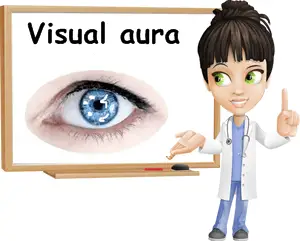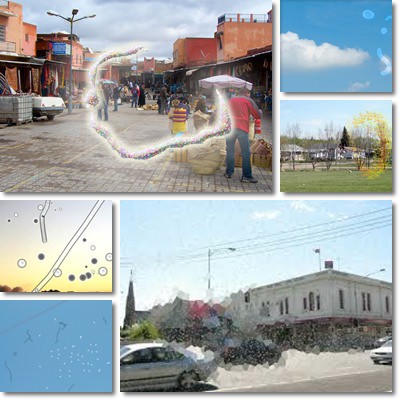Visual aura refers to changes in one’s field of vision such as squiggly lines, shimmering spots or lines, zigzag or flashing lines, even stars or irregular wavy scintillating lines or flickering lights. Visual aura is basically a benign neurological condition that generates simple to complex optical effects. While it may occur on its own, it is known to precede or accompany a migraine. The optical effects it generates usually last up to about 20 minutes.
What is visual aura?
Visual aura is a benign distortion of one’s visual field. It is different from eye floaters and both have distinct causes. Visual aura may or may not reoccur and this depends greatly on what caused it in the first place. For someone who has never experienced such a disturbance in vision, an aura can prove extremely worrisome, especially if it is a more complex optical effect. However, even the most simple of visual disturbances can interfere with driving which is why it is recommended to avoid performing complex tasks until the optical effects of a visual aura withdraw.

Visual aura symptoms and types
Here is a list of simple and complex optical effects that can be classified as visual aura:
- Bright flashing or flickering lights.
- Shimmering dots, spots or patches.
- Zigzag, curved, wavy or squiggly lines that flicker or shimmer.
- Shimmering or dark spots that develop gradually and spread.
- Whitish or shimmering stars.
- Blind spots or patches that spread across one’s field of vision.
- Expansion of one’s blind spot.
- Deformed perception of the size of objects in one’s field of vision.
- Tunnel vision as a result of loss of peripheral vision.
- Photosensitivity.
- Temporary blindness in either one or both eyes.
- Kaleidoscope vision.
What is scintillating scotoma?
Scintillating scotoma is a particular type of visual aura. It appears as spots or patches of shimmering or flickering light in an area of one’s field of vision called scotoma (or blind spot) which then expand towards the center. Lines, arcs or flickering lights, either white or colored may occur. Scotoma is a type of visual aura that refers to actual blind spots or dark patches that start in the scotoma area and slowly spread towards the center of the eye. This type may come to obscure vision in one eye almost completely.
Other signs and symptoms of visual aura
All of these unusual visual symptoms may appear in combination with smell, hearing or other types of neurological distortions such as experiencing strange, unknown smells or tastes, nausea, sudden anxiety, tingling and numbness sensation, confusion, weakness or slurred speech. While seizures are rare occurrences, migraines are very likely to occur. Usually, visual auras accompany migraines in the majority of cases.

My personal experience with visual aura
When I first experienced a visual aura I was extremely panicked because I thought I was going blind. It was a couple of years back and I was driving into town at noon on a beautiful summer day. 5 minutes into the drive, I felt my left eye very teary and I assumed it was because of the bright light. Almost instantly I started seeing several shimmering, whitish lines which appeared to move across my field of vision.
While they disappeared in about 20 minutes, I couldn’t see well and had to pull the car over.
In my case, the visual aura shimmering lines were caused by lack of sleep (I had only slept two hours the night before) and a serious migraine brought on by putting up some shelves on the wall early in the morning. I heard the noise from the hammer throbbing in my ears for hours afterwards and deduced it was the cause behind the visual distortions I was experiencing.
Visual aurae can have a variety of causes or can be a side effect of another medical problem or condition such as migraines. If you experience both migraines and visual aura, then what is causing your migraines is also causing the visual aurae.
Visual aura causes and triggers
Here is a list of potential triggers of visual aura:
- Stress and sleep deprivation.
- The strain caused by lifting heavy weights or intense exercising.
- Nutrient deficiencies (magnesium deficit is a possible cause).
- Loud, repetitive noises (such as a hammer noises).
- Irritants such as dust or irritant chemical substances (from cleaning products).
- Pollen or other allergens.
- Certain foods one is intolerant of.
- Psychological conditions (depression, anxiety).
- Anomalies in the occipital cortex (the back part of the brain responsible for vision).
- Other medical conditions: synesthesia, hallucinations, seizures, epilepsy, migraines, local inflammation, rarely retinal tear, ischemia, myopia, uveitis etc.
- Sudden movements of the eye.
- Aging (visual auras are more likely to occur in individuals over 40).
- Alcohol, coffee and caffeinated beverages.
- Food additives such as nitrates, monosodium glutamate or tyramine may play a role.
Flickers and shimmering in one’s field of vision may have to do with problems with the retinal photoreceptors which are specialized cells in the retina. These retina cells convert light into signals that help us understand the visual world. But with time, the vitreous humour (the gel-like substance in between the retina and the lens) may either liquefy or collapse.
This means that the vitreous tugs on the retina, causing an inappropriate activation of the photoreceptor cells and subsequent flickers, shimmers or flashes of light. This would explain why loud noises, lifting weights and lack of sleep lead to visual aura. Problems with retinal photoreceptors and subsequent optical disturbances are more common in people with migraines, ischemia, glaucoma, uveitis, myopia and the elderly. However, the symptoms should last no more than 20-60 minutes at a time and resolve themselves in 2-3 days at most. In most cases, visual auras are no reason for concern and pose no health risk.
How long do visual aurae last?
Symptoms may last anywhere from 20 minutes to an hour. If they occur for more than 2-3 days, then a visit to the ophthalmologist is in order to rule out any serious underlying health problem. Unlike visual aurae, eye floaters are particles physically present in the vitreous humour of the eye and usually do not disappear.
Treatment for visual auras
Visual auras do not generally require treatment, but rather resolve themselves. But for this to happen, you may need to identify what has been causing these optical disturbances in the first place and learn to avoid it. If the optical effects are a only a symptom of an underlying medical condition, then it is best to see your doctor for professional treatment.
Here are a few tips and tricks that may help prevent and even treat visual auras:
- Getting enough sleep.
- Relieving stress.
- Staying away from loud noises.
- Using hearing protection (earplugs, earmuffs).
- Eating balanced, nutritious meals.
- Taking dietary supplements to promote vision health.
- Ceasing activities such as reading or driving when visual disturbances appear.
- Monitoring alcohol, coffee and caffeinated beverages intake.
Sleeping enough should help relieve strain on the eyes and promote good vision. Because dietary habits play an important part in migraine control and visual auras often accompany migraines, it might be best to monitor your coffee, alcohol, caffeinated beverages, luncheon meats etc. intake. Similarly, having a balanced diet that supplies essential nutrients such as carotenoid antioxidants, vitamins A and C and dietary minerals is recommended.
Some people report feeling better after taking magnesium supplements, but research on the subject is lacking. It has been suggested that women with a history of migraines with auras should be careful with any form of hormone replacement therapy they may be under because hormonal fluctuations may play a role in triggering migraines and visual aura.
Using hearing protection when in loud environments is recommended. Similarly, lifting heavy weights should be avoided if you notice the strain of lifting triggers visual auras. It is also extremely important to cease dangerous activities such as driving or operating heavy machinery as soon as the visual disturbances occur to avoid accidents.
